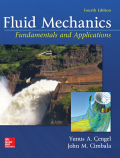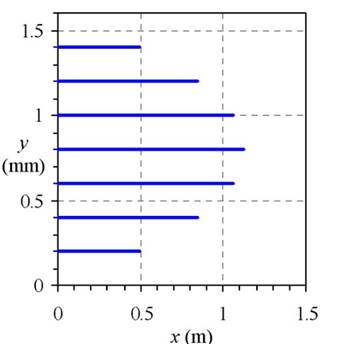
Concept explainers
The seven streak lines generated from a dye rake that introduce dye streaks at
Answer to Problem 103P
The seven streak lines generated from the dye rake are:
Explanation of Solution
Write the expression for the two dimensional Poiseuille flow.
Here, the distance between the plates is
Write the expression for the streak line generation equation.
Substitute
Conclusion:
Substitute 0 for
Substitute
Substitute
Substitute
Substitute the values of
|
| |
|
| |
|
| |
Table-(1)
Plot the values of

Figure-(1)
The figure (1) represents the graph generated from a dye rake.
Want to see more full solutions like this?
Chapter 4 Solutions
Fluid Mechanics: Fundamentals and Applications
- A potential steady and incompressible air flow on x-y plane has velocity in y-direction v= - 6 xy . Determine the velocity in x-direction u=? and Stream Function SF=? ( x2 : square of x ; x3: third power of x ; y2: square of y , y3: third power of y)ANSWER: u= 3 x2 - 3 y2 SF= 3 x2 y - y3arrow_forwardThe stream function of a flow field is y = Ax3 – Bxy², where A = 1 m1s1 and B = 3 m-1s1. (a) Derive the velocity vector (b) Prove that the flow is irrotational (c) Derive the velocity potentialarrow_forwardA frictionless, incompressible steady flow field is given byV = 2xyi - y2jin arbitrary units. Let the density be ρ 0 = constant andneglect gravity. Find an expression for the pressure gradientin the x direction.arrow_forward
- The velocity field for a line vortex in the r?-plane is given byur = 0 u? = K / rwhere K is the line vortex strength. For the case with K = 1.5 m/s2, plot a contour plot of velocity magnitude (speed). Specifically, draw curves of constant speed V = 0.5, 1.0, 1.5, 2.0, and 2.5 m/s. Be sure to label these speeds on your plot.arrow_forwardLaminar Flow in a Vertical Cylindrical Annulus Derive the equation for steady-state laminar flow inside the annulus between two concentric vertical pipes. This type of flow occurs often in concentric pipe heat exchangers. max velocity profilearrow_forwardOuter pipe wall Consider the steady, incompressible, laminar flow of a Newtonian fluid in an infinitely long round pipe annulus of inner radius R, and outer radius Ro. Assume that the pressure is constant everywhere there is no forced pressure gradient driving the flow, Pi = P2. However, let the inner cylinder be moving at steady velocity V to the right, essentially a piston. The outer cylinder is stationary. This makes an axisymmetric Couette flow. Use cylindrical coordinates and the equations of motion to generate an expression for the x-component of velocity u as a function of r. Ignore the effects of gravity. Fluid: p, H iP R; R, ƏP_ P2- P1 ax x2-X1arrow_forward
- IRCIC Next Generat... A TASHRM The velocity field for a fluid flow is given by following expression: V (0.2x² +2y+2.5)i +(0.5x+2y -6)j+(0.15x +3y + z)k The strain tensor at (2,1,-1) will be: 0.8 1.25 0.30 a)-1.25 -4 0.30 -1 0.8 1.25 0.70) b) 1.25 4 2 0.30 -2 0.8 1.25 0.30 c) | 1.25 4 -2 0.30 -2 0.8 1.25 0.30 O Tvne aere to searcharrow_forwardThe equation of streamline passing through (1, 1) for the velocity function V = -y?i – 6xj isarrow_forwardQ1:- (a) Show that stream function exists as a consequence ofequation of continuity.(b) Show that potential function exists as a consequence ofirrotational flowarrow_forward
- (a) In a variety of environmental problems, it is common to find fluid motions that have a cellular character; i.e. the fluid streamlines form closed loops in the form of a cell. An example of a 2D cellular flow is ū = sin(rx) cos(ry)î – cos(rx) sin(ry)j (i) Is this flow incompressible? (Justify you answer.) (ii) Calculate the vorticity. (iii) Where is the magnitude of the vorticity highest, and where does it vanish?arrow_forwardConsider the flow field V = (ay+dx)i + (bx-dy)j + ck, where a(t), b(t), c(t), and d(t) are time dependent coefficients. Prove the density is constant following a fluid particle, then find the pressure gradient vector gradP, Γ for a circular contour of radius R in the x-y plane (centered on the origin) using a contour integral, and Γ by evaluating the Stokes theorem surface integral on the hemisphere of radius R above the x-y plane bounded by the contour.arrow_forwardPlease help me in answering the following practice question. Thank you for your help. Consider several elementary planar irrotational flows arranged in a plane in a cartesian coordinate system (x-y plane) with the unit of length in m (meter). A line source with strength 18 m^2/s is located at point A (0, 1); a line sink with strength of 15 m^2/s is located at point B (3, -2); a line vortex with strength of 9 m^2/s is located at point C (4, 1); and a uniform flow of 10 m/s is at angle 30° with positive x-direction (counter-clockwise). Find the resultant velocity and pressure induced at point D (2, 0) by the uniform stream, line source, line sink & line vortex. Pressure at the infinity at upstream of uniform flow is 1000 Pa.Please list all necessary assumptions.arrow_forward
 Elements Of ElectromagneticsMechanical EngineeringISBN:9780190698614Author:Sadiku, Matthew N. O.Publisher:Oxford University Press
Elements Of ElectromagneticsMechanical EngineeringISBN:9780190698614Author:Sadiku, Matthew N. O.Publisher:Oxford University Press Mechanics of Materials (10th Edition)Mechanical EngineeringISBN:9780134319650Author:Russell C. HibbelerPublisher:PEARSON
Mechanics of Materials (10th Edition)Mechanical EngineeringISBN:9780134319650Author:Russell C. HibbelerPublisher:PEARSON Thermodynamics: An Engineering ApproachMechanical EngineeringISBN:9781259822674Author:Yunus A. Cengel Dr., Michael A. BolesPublisher:McGraw-Hill Education
Thermodynamics: An Engineering ApproachMechanical EngineeringISBN:9781259822674Author:Yunus A. Cengel Dr., Michael A. BolesPublisher:McGraw-Hill Education Control Systems EngineeringMechanical EngineeringISBN:9781118170519Author:Norman S. NisePublisher:WILEY
Control Systems EngineeringMechanical EngineeringISBN:9781118170519Author:Norman S. NisePublisher:WILEY Mechanics of Materials (MindTap Course List)Mechanical EngineeringISBN:9781337093347Author:Barry J. Goodno, James M. GerePublisher:Cengage Learning
Mechanics of Materials (MindTap Course List)Mechanical EngineeringISBN:9781337093347Author:Barry J. Goodno, James M. GerePublisher:Cengage Learning Engineering Mechanics: StaticsMechanical EngineeringISBN:9781118807330Author:James L. Meriam, L. G. Kraige, J. N. BoltonPublisher:WILEY
Engineering Mechanics: StaticsMechanical EngineeringISBN:9781118807330Author:James L. Meriam, L. G. Kraige, J. N. BoltonPublisher:WILEY





